Public Service Enterprise Group Bundle
Who are PSEG's Customers, and How Does it Serve Them?
In the ever-changing energy landscape, understanding Public Service Enterprise Group SWOT Analysis is crucial for any investor or stakeholder. For PSEG, a company with a century-long legacy, identifying its customer demographics and target market is key to its future. This analysis delves into the core of PSEG's strategy, exploring how it serves its diverse customer base.
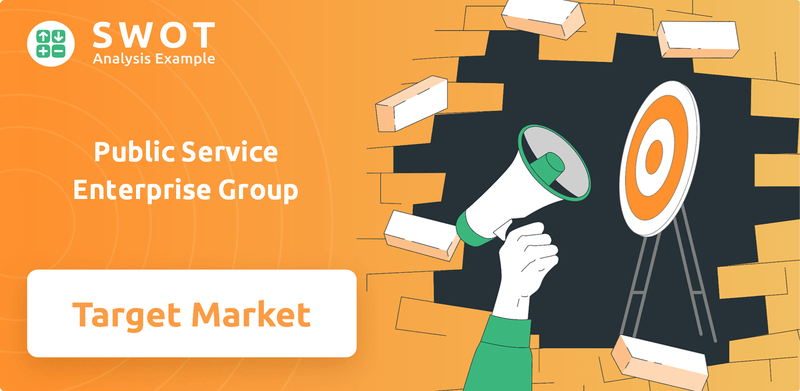
This exploration of PSEG's customer demographics and target market will reveal the company's strategic adaptations. We'll examine the PSEG customer profile, including factors like age, income, and location, to understand its market segmentation approach. By understanding the needs of PSEG's customers and their behavior, we can better assess its market position and future growth potential, considering aspects like PSEG customer age distribution and PSEG customer income levels.
Who Are Public Service Enterprise Group’s Main Customers?
Understanding the customer demographics and target market for Public Service Enterprise Group (PSEG) is crucial for assessing its business strategy. PSEG serves a diverse customer base, primarily through its regulated utility, PSE&G, and its power generation arm, PSEG Power. This includes both residential and business customers, reflecting a broad market reach.
As of the end of 2024, PSE&G serves approximately 2.4 million electric customers and 1.9 million natural gas customers within New Jersey. The customer mix varies between electric and gas services, indicating how PSEG segments its market. This segmentation is key to understanding PSEG's customer profile and adapting its services to meet specific needs.
The target market for PSEG is segmented into residential, commercial, and industrial sectors. For electric sales, the breakdown is 34% residential, 57% commercial, and 9% industrial. Gas sales are distributed as 58% residential, 38% commercial, and 4% industrial. This distribution highlights the importance of the residential sector for both electricity and gas, while commercial customers are a significant component, especially for electricity.
PSEG's customer base is segmented by service type (electric and gas) and sector (residential, commercial, and industrial). This segmentation helps tailor services and infrastructure investments. Analyzing these segments provides insights into customer behavior analysis and informs customer acquisition strategies.
PSEG primarily operates in New Jersey, with a focus on infrastructure modernization and energy efficiency. The geographic concentration allows for targeted investments and customer service strategies. This localized approach helps in understanding PSEG customer location data.
PSEG Long Island offers incentives to Low-to-Moderate Income (LMI) residential customers. These programs, such as Home Comfort LMI and REAP, show an understanding of diverse income levels. This focus helps to address the needs of PSEG's customers.
Customer growth for electric and gas residential customers was approximately 1% for the trailing 12 months ended December 31, 2024. This growth is driven by demographic shifts, electric vehicle adoption, and clean energy trends. Further information can be found in the Growth Strategy of Public Service Enterprise Group.
While specific demographic breakdowns are not extensively detailed, PSEG's operations suggest a diverse customer base. The company's focus on infrastructure and energy efficiency initiatives reflects an understanding of evolving customer needs.
- Residential customers form a significant portion of the market.
- Commercial customers are a major segment, especially for electric sales.
- Income-based programs indicate awareness of varying financial situations.
- Customer growth is influenced by broader demographic trends and clean energy adoption.
Public Service Enterprise Group SWOT Analysis
- Complete SWOT Breakdown
- Fully Customizable
- Editable in Excel & Word
- Professional Formatting
- Investor-Ready Format
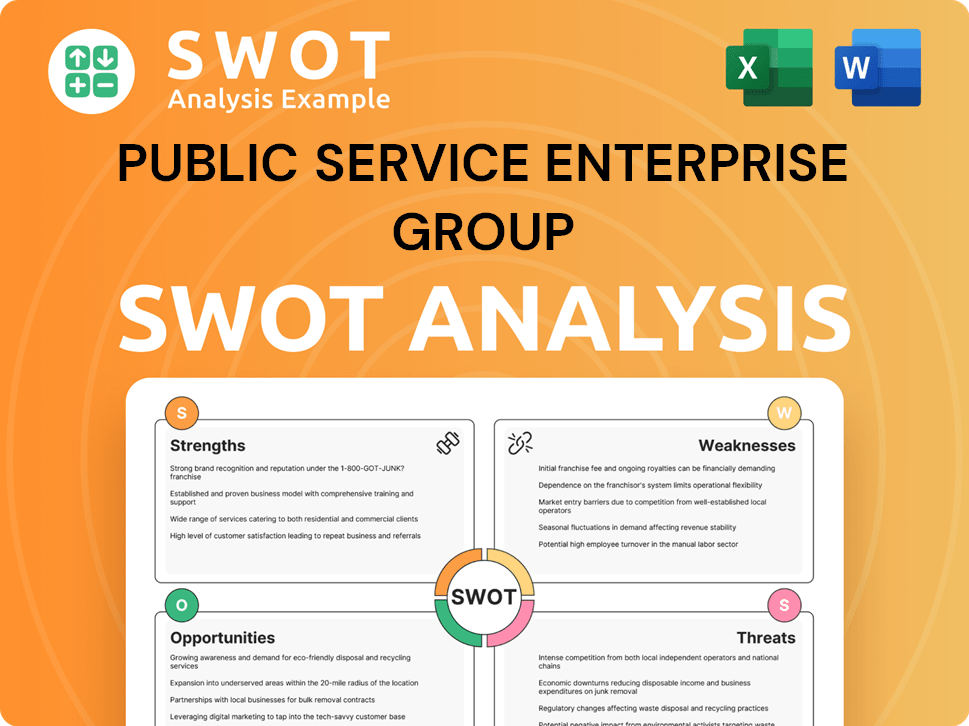
What Do Public Service Enterprise Group’s Customers Want?
Understanding the needs and preferences of customers is crucial for success. For Public Service Enterprise Group (PSEG), this means focusing on reliability, affordability, and sustainability. These factors drive customer satisfaction and influence purchasing decisions within the utility sector.
PSEG's customers prioritize safe, affordable, and dependable power. The company's initiatives and programs are designed to meet these needs. By understanding these priorities, PSEG can tailor its services and programs to enhance customer satisfaction and loyalty.
PSEG's commitment to meeting customer needs is evident through various programs and initiatives. These efforts are designed to address common pain points and provide value beyond basic service, leading to increased customer satisfaction and loyalty.
Customers of PSEG highly value reliable service. PSE&G, a part of PSEG, ranked first in residential customer satisfaction for both gas and electric utilities in the East among large utilities in 2024, according to J.D. Power.
PSEG addresses customer preferences for energy efficiency and cost savings through programs like the Clean Energy Future – Energy Efficiency (CEF-EE) initiatives. Nearly 415,000 customers have participated in these programs as of February 2025.
These energy efficiency programs have collectively saved customers nearly $640 million annually on their utility bills. They also contribute to reducing carbon emissions, aligning with sustainability goals.
The Clean Energy Future – Energy Efficiency II program, approved with approximately $2.9 billion in spending from January 2025 to June 2027, aims to help customers save energy, lower bills, and reduce carbon emissions.
PSEG Long Island's 2025 Energy Efficiency (EE) portfolio, with a proposed budget of $92.45 million, includes rebates and incentives for energy-efficient products and heat pumps, demonstrating tailored approaches.
The company also works directly with customers and community organizations to inform them about energy assistance options. Approximately 226,000 customers received over $265 million in support in the past year.
The customer profile for PSEG is diverse, encompassing residential, commercial, and industrial sectors. PSEG's target market analysis reveals a focus on providing reliable and affordable energy solutions. The company's market segmentation strategy includes initiatives tailored to specific segments, such as low-to-moderate income residential customers. To learn more about the company's financial performance and business model, see Revenue Streams & Business Model of Public Service Enterprise Group.
PSEG's customer behavior analysis indicates that customers prioritize several key needs:
- Reliable power supply.
- Affordable energy costs.
- Energy efficiency and sustainability options.
- Access to energy assistance programs.
Public Service Enterprise Group PESTLE Analysis
- Covers All 6 PESTLE Categories
- No Research Needed – Save Hours of Work
- Built by Experts, Trusted by Consultants
- Instant Download, Ready to Use
- 100% Editable, Fully Customizable
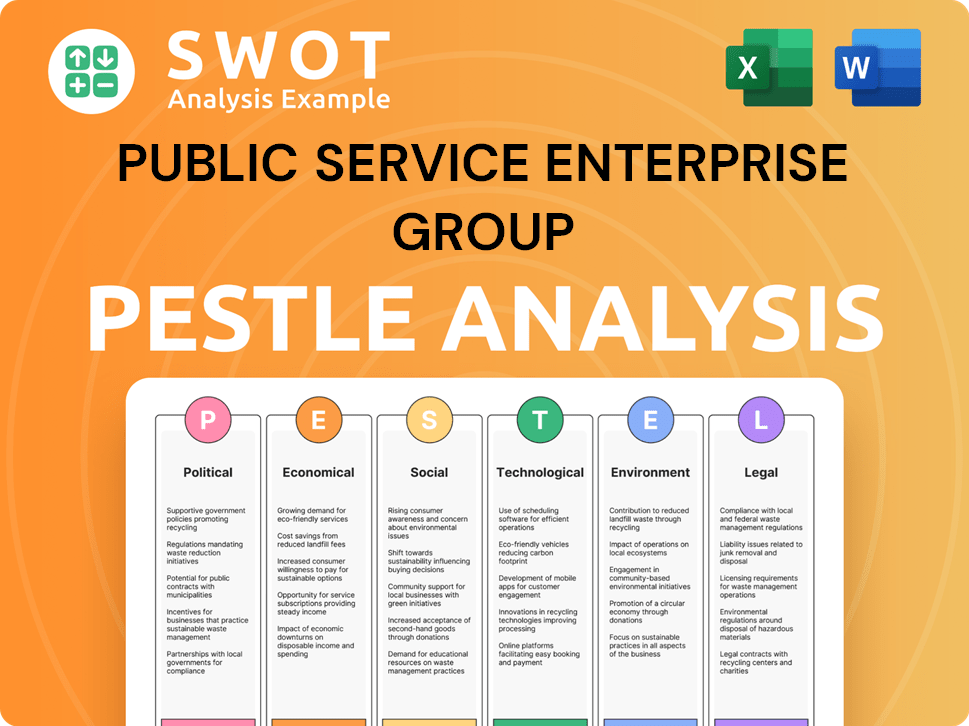
Where does Public Service Enterprise Group operate?
The geographical market presence of Public Service Enterprise Group (PSEG) is primarily concentrated in New Jersey, along with parts of Pennsylvania and Long Island, New York. Its main subsidiary, Public Service Electric & Gas Co. (PSE&G), serves as New Jersey's largest transmission and distribution utility. The company's operations are strategically focused within these regions, ensuring a localized approach to customer needs and regulatory frameworks.
PSE&G's service territory in New Jersey covers approximately 2,600 square miles, reaching about 74% of the state's population. PSEG Power operates nuclear power generating units in New Jersey and Pennsylvania. PSEG Long Island serves customers on Long Island, New York, under a contract with the Long Island Power Authority (LIPA), which is set to expire in 2025.
The company's approach to its target market considers the distinct characteristics of each region. For example, the New Jersey Board of Public Utilities (BPU) approved new electric and gas base distribution rates for PSE&G effective October 15, 2024. PSEG's Clean Energy Future – Energy Efficiency II program in New Jersey exemplifies its commitment to meeting the specific needs of its customers in this area. The company's capital investment plan of $21 billion to $24 billion from 2025 through 2029 will focus on infrastructure modernization and meeting growing energy demand within its service territories.
PSEG's primary service areas are:
- New Jersey: PSE&G is the main utility provider.
- Pennsylvania: PSEG Power operates nuclear power plants.
- Long Island, New York: PSEG Long Island serves customers.
Public Service Enterprise Group Business Model Canvas
- Complete 9-Block Business Model Canvas
- Effortlessly Communicate Your Business Strategy
- Investor-Ready BMC Format
- 100% Editable and Customizable
- Clear and Structured Layout
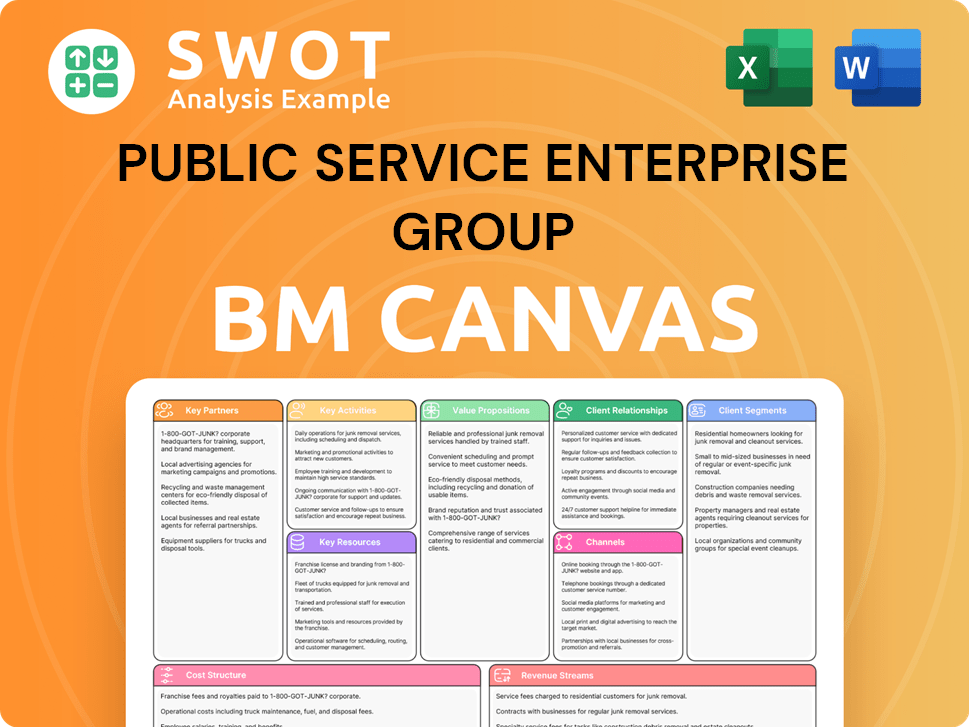
How Does Public Service Enterprise Group Win & Keep Customers?
PSEG's approach to customer acquisition and retention is centered on delivering reliable and sustainable energy solutions. Their strategies are designed to enhance customer satisfaction and encourage long-term loyalty. The company focuses on operational excellence and continuous improvement to meet the evolving needs of its customer base.
A key component of PSEG's strategy involves significant investments in infrastructure modernization. These investments are aimed at improving service reliability and supporting the adoption of modern energy solutions. By focusing on these areas, PSEG aims to attract new customers and retain existing ones by providing superior service and value.
Customer satisfaction is a top priority for PSEG. In 2024, PSE&G was recognized as #1 in Customer Satisfaction with Residential Electric and Gas Service in the East among Large Utilities by J.D. Power, highlighting their commitment to customer service. This recognition, combined with their focus on energy efficiency and affordability, supports their ability to attract and retain customers. For more insights, explore the Growth Strategy of Public Service Enterprise Group.
PSEG plans to invest approximately $3.8 billion in regulated investments for 2025. These investments will focus on infrastructure upgrades, energy efficiency, electrification initiatives, and load growth. These upgrades directly enhance service reliability and support customer needs.
Through its Clean Energy Future – Energy Efficiency (CEF-EE) programs, PSEG has helped nearly 415,000 customers reduce energy usage. These programs have generated approximately $640 million in annual savings for these customers as of February 2025. These programs attract customers looking to lower costs and reduce their environmental impact.
PSEG actively identifies and supports customers eligible for energy assistance and affordability options. In the past year, around 226,000 customers received over $265 million in support. This targeted approach demonstrates their commitment to customer care and helps retain customers.
PSEG Long Island has utilized digital platforms like YouTube, CBS, and Newsday for advertising as recently as March 2025. This indicates a blend of digital and traditional media. This approach helps in reaching a broad audience and promoting their services.
PSEG's success in customer retention is driven by several factors, including high customer satisfaction scores and consistent service reliability. These elements are crucial for maintaining customer loyalty and attracting new customers.
- Customer Satisfaction: J.D. Power recognized PSE&G as #1 in Customer Satisfaction with Residential Electric and Gas Service in the East among Large Utilities in 2024.
- Reliability Performance: Awarded the ReliabilityOne® Award for Outstanding Metropolitan Service Area Reliability Performance in the Mid-Atlantic region for the 23rd consecutive year.
- Energy Efficiency Programs: Providing savings and environmental benefits through programs like CEF-EE.
Public Service Enterprise Group Porter's Five Forces Analysis
- Covers All 5 Competitive Forces in Detail
- Structured for Consultants, Students, and Founders
- 100% Editable in Microsoft Word & Excel
- Instant Digital Download – Use Immediately
- Compatible with Mac & PC – Fully Unlocked
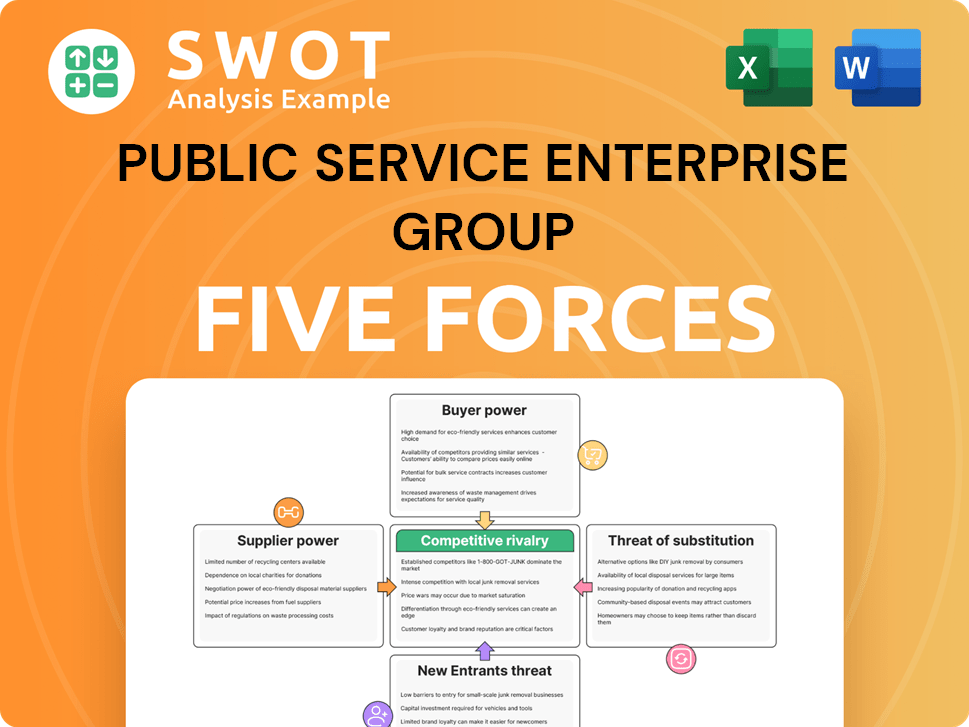
Related Blogs
- What are Mission Vision & Core Values of Public Service Enterprise Group Company?
- What is Competitive Landscape of Public Service Enterprise Group Company?
- What is Growth Strategy and Future Prospects of Public Service Enterprise Group Company?
- How Does Public Service Enterprise Group Company Work?
- What is Sales and Marketing Strategy of Public Service Enterprise Group Company?
- What is Brief History of Public Service Enterprise Group Company?
- Who Owns Public Service Enterprise Group Company?
Disclaimer
All information, articles, and product details provided on this website are for general informational and educational purposes only. We do not claim any ownership over, nor do we intend to infringe upon, any trademarks, copyrights, logos, brand names, or other intellectual property mentioned or depicted on this site. Such intellectual property remains the property of its respective owners, and any references here are made solely for identification or informational purposes, without implying any affiliation, endorsement, or partnership.
We make no representations or warranties, express or implied, regarding the accuracy, completeness, or suitability of any content or products presented. Nothing on this website should be construed as legal, tax, investment, financial, medical, or other professional advice. In addition, no part of this site—including articles or product references—constitutes a solicitation, recommendation, endorsement, advertisement, or offer to buy or sell any securities, franchises, or other financial instruments, particularly in jurisdictions where such activity would be unlawful.
All content is of a general nature and may not address the specific circumstances of any individual or entity. It is not a substitute for professional advice or services. Any actions you take based on the information provided here are strictly at your own risk. You accept full responsibility for any decisions or outcomes arising from your use of this website and agree to release us from any liability in connection with your use of, or reliance upon, the content or products found herein.